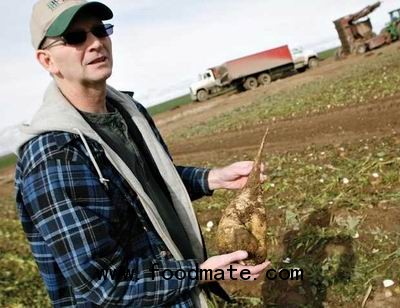
One beet, caked with mud, is about the size of a toddler's head.
The recent rains have added an extra challenge to harvesting Washington's remaining sugar beet acres near Paterson, said Ryan Munn, one of the owners of R. Munn Farms.
The rain and mud will make harvest last three weeks, instead of two, he said. Tractors pulled trucks through one of Munn's fields earlier this week.
The harvesters fill each truck with about 13 tons of sugar beets, all of which will head 250 miles away to Amalgamated Sugar of Nampa, Idaho, where sugar will be extracted from the beets to form the white, brown and liquid sugars that Americans consume, Munn said.
Once it's processed, Munn said there is no difference between sugar from sugar cane or sugar beets.
Just one acre of sugar beets from this area can create about 11,000 pounds of sugar, he said. That's from an average of 42 to 46 tons per acre.
Sugar beets look like giant turnips, and may weight around 3 pounds. While most are white, a few in Munn's field were a lush red. Munn said the sugar beets are a mix of varieties, and every once in a while, the color of the root vegetable shows that one of its parents was a red beet.
Munn rotates the crops on his land in a four-year cycle, with a rotation crop such as peas or green beans, then grass seed, followed by onions and sugar beets.
Onions are the crop that gives Munn the most potential for profit. But, "beets are much more steady," he said.
Sugar beets are easy to grow, once the plants get started, Munn said. Irrigation is a necessity here, where Munn said they may get 7 inches of rain.
They are planted in March, and harvest mid-October, he said. The longer they stay in the ground, the more sugar the beets contain.
Munn said they started harvest Oct. 15 this year.
First, a beater goes over the rows of sugar beets, hitting the leafy heads with rubber flails, and scalping off the top of the beets.
Then, the harvester comes, with a truck driving parallel to store all the sugar beets. It takes about 20 people total to harvest the root vegetable.
Each truck takes its load to the beet dump on Munn's farm, where beets are piled to store until a semi comes to truck them to Idaho. By the time harvest is complete, Munn estimates his 25-foot-tall pile will be about 200 yards long.
Munn said he only knows of three farms, including his own, that grow sugar beets for sugar extraction in Washington. All three farms are members of Sunheaven Farms, an irrigation system partnership that includes R. Munn Farms and four other area farms.
R. Munn Farms was putting in sugar beets in the late 1980s, while others were taking them out. They've always grown the beets for Amalgamated Sugar, a co-op owned by the farmers who grow for it. The co-op determines how many acres each farm can grow in a given year, said Munn, who is on the board of directors.
Washington's sugar beet decline started when Utah & Idaho Sugar Co. closed the only two refineries in the state in 1979, one in Toppenish and the other in Moses Lake. Attempts to resurrect the industry in the 1990s failed, with Pacific Northwest Sugar Co. of Moses Lake closing its doors in 2002, according to Herald archives.
Sugar beets once covered about 95,000 acres in the Columbia Basin, according to Herald archives.
Washington had only 2,076 acres of sugar beets in recent years, all in Benton County, according to the U.S. Department of Agriculture.
Those acres are the ones Munn said he and farmers Brent Hartley and Brent Schulthies grow.





